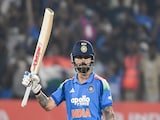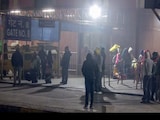Malakpur is currently home to about 650 Muslim families who fled the violence.
Malakpur Refugee Camp, Shamli, Uttar Pradesh:
To escape the bitter cold that sets in at night, Ayan, two years old, came too close to a small fire his parents had lit inside the tent which serves as a makeshift home.
His parents, who come from Illam village, say that he was half asleep when he stumbled over to the embers to stay warm, but instead, ended up with burns on his legs.
The father of three-year-old Anas, tells us his son burnt his hand trying to warm them.
Anas and Ayan are amongst the youngest residents of the Malakpur Refugee Camp, a tent city that has sprung up in a patch of cleared forest in Shamli district in the aftermath of the Muzaffarnagar riots.
Malakpur is currently home to about 650 Muslim families who fled the violence. The government recognises four such camps in Shamli and one in Muzaffarnagar. NGOs and activists say the number of camps is much higher, at 16 in Shamli alone. Here, at Malakpur, as elsewhere, the threat of communal violence has receded. The latest danger comes from the bitter winter.
Camp residents claim nearly a dozen children have died in the past month, mainly because of the cold, news which has stirred the conscience of the country.
On the day we visited, we found blankets, some of them the result of an NDTV campaign, were being used, as were sweaters donated by well-wishers. (Donate blankets for Muzaffarnagar relief camps)
We also found evidence of the impact of the Supreme Court's recent hauling up of the UP government for not protecting the children of the refugee camps, in the form of better quality of medical help.
Until four days ago, the presence of a government doctor at Malakpur was rare. But now, they come regularly and are better equipped with a range of drugs. Earlier, camp residents told us that they were prescribed the same two medicines for all ailments.
But the government seems unconcerned about the unsanitary conditions of the camp, which pose a high risk, especially to the young. For a camp of 3000 people, there are only two toilet blocks, now closed, opened for our cameras to capture their appalling, over-clogged reality.
Afsana, from Kithal village, lost her two year old daughter to pneumonia, one of at least a dozen children who have died here, in the past three months.
Now she is worried about her other child, who she says has fever, vomiting and diarrhoea.
The District Magistrate of Shamli, Praveen Kumar Singh says he regrets the death of children, but that the government's medical cover only extends to daytime hours, not at night.
He says they cannot guarantee the safety of camp residents as long as they live in the open.
The somewhat halting nature of official support to camps like Malakpura has to do with the Uttar Pradesh government's continuing struggle to close down this, and other camps. They say the camps are only meant for those villages where there have been deaths, or homes burnt. Much of those in Malakpura have come from villages where there has been neither, the trigger for the exodus being simply fear.
They now refuse to go back. Ayan's mother questioned the government's logic: "Will they only help us if we had been killed?"
As the two sides wrangle, the graveyard abutting Malakpura is testimony to how, for the very young, this camp has already become a permanent home.
We are shown the grave of three-week-old Adil, the child of Anwar, born in this camp, and who died here.
His parents, who come from Illam village, say that he was half asleep when he stumbled over to the embers to stay warm, but instead, ended up with burns on his legs.
The father of three-year-old Anas, tells us his son burnt his hand trying to warm them.
Anas and Ayan are amongst the youngest residents of the Malakpur Refugee Camp, a tent city that has sprung up in a patch of cleared forest in Shamli district in the aftermath of the Muzaffarnagar riots.
Malakpur is currently home to about 650 Muslim families who fled the violence. The government recognises four such camps in Shamli and one in Muzaffarnagar. NGOs and activists say the number of camps is much higher, at 16 in Shamli alone. Here, at Malakpur, as elsewhere, the threat of communal violence has receded. The latest danger comes from the bitter winter.
Camp residents claim nearly a dozen children have died in the past month, mainly because of the cold, news which has stirred the conscience of the country.
On the day we visited, we found blankets, some of them the result of an NDTV campaign, were being used, as were sweaters donated by well-wishers. (Donate blankets for Muzaffarnagar relief camps)
We also found evidence of the impact of the Supreme Court's recent hauling up of the UP government for not protecting the children of the refugee camps, in the form of better quality of medical help.
Until four days ago, the presence of a government doctor at Malakpur was rare. But now, they come regularly and are better equipped with a range of drugs. Earlier, camp residents told us that they were prescribed the same two medicines for all ailments.
But the government seems unconcerned about the unsanitary conditions of the camp, which pose a high risk, especially to the young. For a camp of 3000 people, there are only two toilet blocks, now closed, opened for our cameras to capture their appalling, over-clogged reality.
Afsana, from Kithal village, lost her two year old daughter to pneumonia, one of at least a dozen children who have died here, in the past three months.
Now she is worried about her other child, who she says has fever, vomiting and diarrhoea.
The District Magistrate of Shamli, Praveen Kumar Singh says he regrets the death of children, but that the government's medical cover only extends to daytime hours, not at night.
He says they cannot guarantee the safety of camp residents as long as they live in the open.
The somewhat halting nature of official support to camps like Malakpura has to do with the Uttar Pradesh government's continuing struggle to close down this, and other camps. They say the camps are only meant for those villages where there have been deaths, or homes burnt. Much of those in Malakpura have come from villages where there has been neither, the trigger for the exodus being simply fear.
They now refuse to go back. Ayan's mother questioned the government's logic: "Will they only help us if we had been killed?"
As the two sides wrangle, the graveyard abutting Malakpura is testimony to how, for the very young, this camp has already become a permanent home.
We are shown the grave of three-week-old Adil, the child of Anwar, born in this camp, and who died here.















